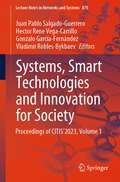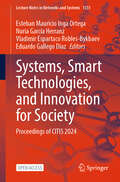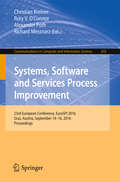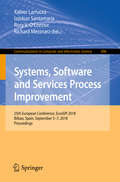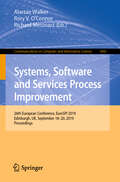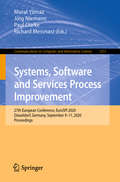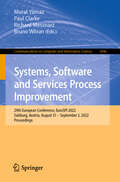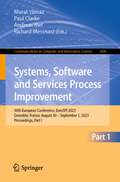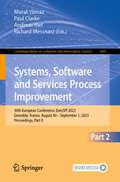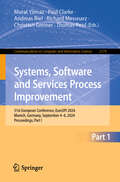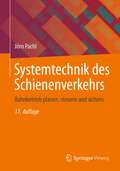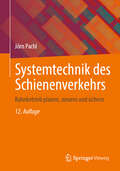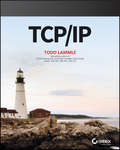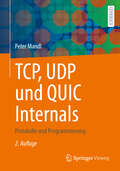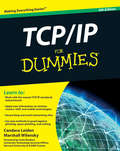- Table View
- List View
Systems, Smart Technologies and Innovation for Society: Proceedings of CITIS´2023, Volume 1 (Lecture Notes in Networks and Systems #870)
by Juan Pablo Salgado-Guerrero Vladimir Robles-Bykbaev Hector Rene Vega-Carrillo Gonzalo García-FernándezThis book is dedicated to exploring the practical applications and future perspectives of intelligent technologies. It delves into various domains, including industry, mobility, telecommunications, and environmental considerations.The innovative nature of this text enables us to draw connections between technical advancements and experiences aimed at enhancing the integration of emerging technologies on local, national, and regional scales. It showcases the strides made in diverse engineering domains, underlining the book’s multidisciplinary appeal. This book is intended for a wide readership, catering to master's and doctoral students, professors, and researchers in the field of cutting-edge technologies. It also extends its relevance to businesses engaged in engineering development. The contents offer insights into novel methodologies, real-world case studies, and innovative techniques designed to optimize systems, ultimately contributing to societal progress.
Systems, Smart Technologies and Innovation for Society: Proceedings of CITIS’2023, Volume 2 (Lecture Notes in Networks and Systems #871)
by Juan Pablo Salgado-Guerrero Vladimir Robles-Bykbaev Hector Rene Vega-Carrillo Gonzalo García-FernándezThis book is dedicated to exploring the practical applications and future perspectives of intelligent technologies. It delves into various domains, including industry, mobility, telecommunications, and environmental considerations. The innovative nature of this text enables us to draw connections between technical advancements and experiences aimed at enhancing the integration of emerging technologies on local, national, and regional scales. It showcases the strides made in diverse engineering domains, underlining the book’s multidisciplinary appeal. This book is intended for a wide readership, catering to master's and doctoral students, professors, and researchers in the field of cutting-edge technologies. It also extends its relevance to businesses engaged in engineering development. The contents offer insights into novel methodologies, real-world case studies, and innovative techniques designed to optimize systems, ultimately contributing to societal progress.
Systems, Smart Technologies, and Innovation for Society: Proceedings of CITIS 2024 (Lecture Notes in Networks and Systems #1331)
by Esteban Mauricio Inga Ortega Nuria García Herranz Vladimir Espartaco Robles-Bykbaev Eduardo Gallego DiazThis open access book compiles the proceedings of the tenth edition of the International Congress on Science, Technology and Innovation for Society, a key event that addresses in a practical and multidisciplinary way smart technologies and their impact on crucial sectors such as sustainability, environment, information and telecommunications, industry and mobility. Through studies with diverse methodologies, basically applied research, it explores how emerging technologies such as artificial intelligence, machine learning, the Internet of Things and big data are transforming these fields, solving global problems and improving the quality of life. It should be noted that the novelty of the book lies in presenting research that integrates the perspectives of experts from different sectors, combining the technical vision with the analysis of the social, economic and environmental impacts of technological innovation. In this sense, it has a broad scope, as it is aimed at professionals, researchers and students of technology, engineering, data science, sustainability, etc., as well as entrepreneurs and public policy makers. It is also a valuable resource for those interested in understanding how emerging technologies can transform key sectors and contribute to a more sustainable future, from informed decision making in the fields of scientific research, technological innovation; as well as being a source of inspiration for entrepreneurs and project leaders seeking cutting-edge technological solutions. In short, a key work for those who wish to explore the future of smart technologies and their impact on society.
Systems, Software and Services Process Improvement
by Rory V. O'Connor Christian Kreiner Alexander Poth Richard MessnarzThis volume constitutes the refereed proceedings of the 21st EuroSPI conference, held in Luxembourg, in June 2014. The 18 revised papers presented together with 11 invited papers in this volume were carefully reviewed and selected. They are organized in topical sections on SPI and very small entities; process improvement frameworks; testing and improvement issues; SPI and people issues; SPI and quality issues; software processes in various contexts. The volume also contains selected keynote papers from EuroSPI workshops and invited papers covering the topic of creating environments supporting innovation and improvement.
Systems, Software and Services Process Improvement
by Rory V. O'Connor Richard Messnarz Jakub Stolfa Svatopluk StolfaThis volume constitutes the refereed proceedings of the 21st EuroSPI conference, held in Luxembourg, in June 2014. The 18 revised papers presented together with 11 invited papers in this volume were carefully reviewed and selected. They are organized in topical sections on SPI and very small entities; process improvement frameworks; testing and improvement issues; SPI and people issues; SPI and quality issues; software processes in various contexts. The volume also contains selected keynote papers from EuroSPI workshops and invited papers covering the topic of creating environments supporting innovation and improvement.
Systems, Software and Services Process Improvement: 25th European Conference, EuroSPI 2018, Bilbao, Spain, September 5-7, 2018, Proceedings (Communications in Computer and Information Science #896)
by Rory V. O'Connor Richard Messnarz Xabier Larrucea Izaskun SantamariaThis volume constitutes the refereed proceedings of the 25th European Conference on Systems, Software and Services Process Improvement, EuroSPI conference, held in Bilbao, Spain, in September 2018.The 56 revised full papers presented were carefully reviewed and selected from 95 submissions. They are organized in topical sections on SPI context and agility, SPI and safety testing, SPI and management issues, SPI and assessment, SPI and safety critical, gamifySPI, SPI in industry 4.0, best practices in implementing traceability, good and bad practices in improvement, safety and security, experiences with agile and lean, standards and assessment models,team skills and diversity strategies, SPI in medical device industry, empowering the future infrastructure.
Systems, Software and Services Process Improvement: 26th European Conference, EuroSPI 2019, Edinburgh, UK, September 18–20, 2019, Proceedings (Communications in Computer and Information Science #1060)
by Richard Messnarz Rory V. O’Connor Alastair WalkerThis volume constitutes the refereed proceedings of the 26th European Conference on Systems, Software and Services Process Improvement, EuroSPI conference, held in Edinburgh, Scotland, in September 2019. The 18 revised full papers presented were carefully reviewed and selected from 28 submissions. They are organized in topical sections: Visionary Papers, SPI and Safety and Security, SPI and Assessments, SPI and Future Qualification & Team Performance, and SPI Manifesto and Culture. The selected workshop papers are also presented and organized in following topical sections: GamifySPI, Digitalisation of Industry, Infrastructure and E-Mobility. -Best Practices in Implementing Traceability. -Good and Bad Practices in Improvement. -Functional Safety and Cybersecurity. -Experiences with Agile and Lean. -Standards and Assessment Models. -Team Skills and Diversity Strategies. -Recent Innovations.
Systems, Software and Services Process Improvement: 27th European Conference, EuroSPI 2020, Düsseldorf, Germany, September 9–11, 2020, Proceedings (Communications in Computer and Information Science #1251)
by Paul Clarke Murat Yilmaz Richard Messnarz Jörg NiemannThis volume constitutes the refereed proceedings of the 27th European Conference on Systems, Software and Services Process Improvement, EuroSPI conference, held in Düsseldorf, Germany, in September 2020*. The 50 full papers and 13 short papers presented were carefully reviewed and selected from 100 submissions. They are organized in topical sections on visionary papers, SPI manifesto and improvement strategies, SPI and emerging software and systems engineering paradigms, SPI and standards and safety and security norms, SPI and team performance & agile & innovation, SPI and agile, emerging software engineering paradigms, digitalisation of industry, infrastructure and e-mobility, good and bad practices in improvement, functional safety and cybersecurity, experiences with agile and lean, standards and assessment models, recent innovations, virtual reality. *The conference was partially held virtually due to the COVID-19 pandemic.
Systems, Software and Services Process Improvement: 29th European Conference, EuroSPI 2022, Salzburg, Austria, August 31 – September 2, 2022, Proceedings (Communications in Computer and Information Science #1646)
by Paul Clarke Murat Yilmaz Richard Messnarz Bruno WöranThis volume constitutes the refereed proceedings of the 29th European Conference on Systems, Software and Services Process Improvement, EuroSPI 2022, held in Salzburg, Austria, in August-September 2022.The 49 full papers and 8 short papers presented were carefully reviewed and selected from 110 submissions. The papers are organized according to the following topical sections: SPI and emerging and multidisciplinary approaches to software engineering; digitalisation of industry, infrastructure and e-mobility; SPI and good/bad SPI practices in improvement; SPI and functional safety and cybersecurity; SPI and agile; SPI and standards and safety and security norms; SPI and team skills and diversity; SPI and recent innovations; virtual reality and augmented reality.
Systems, Software and Services Process Improvement: 30th European Conference, EuroSPI 2023, Grenoble, France, August 30 – September 1, 2023, Proceedings, Part I (Communications in Computer and Information Science #1890)
by Paul Clarke Murat Yilmaz Richard Messnarz Andreas RielThis two-volume set constitutes the refereed proceedings of the 30th European Conference on Systems, Software and Services Process Improvement, EuroSPI 2023, held in Grenoble, France, in August-September 2023.The 47 full papers presented were carefully reviewed and selected from 100 submissions. The papers are organized according to the following topical sections: SPI and emerging and multidisciplinary approaches to software engineering; digitalisation of industry, infrastructure and e-mobility; SPI and good/bad SPI practices in improvement; SPI and functional safety and cybersecurity; SPI and agile; SPI and standards and safety and security norms; sustainability and life cycle challenges; SPI and recent innovations; virtual reality and augmented reality.
Systems, Software and Services Process Improvement: 30th European Conference, EuroSPI 2023, Grenoble, France, August 30 – September 1, 2023, Proceedings, Part II (Communications in Computer and Information Science #1891)
by Paul Clarke Murat Yilmaz Richard Messnarz Andreas RielThis two-volume set constitutes the refereed proceedings of the 30th European Conference on Systems, Software and Services Process Improvement, EuroSPI 2023, held in Grenoble, France, in August-September 2023.The 47 full papers presented were carefully reviewed and selected from 100 submissions. The papers are organized according to the following topical sections: SPI and emerging and multidisciplinary approaches to software engineering; digitalisation of industry, infrastructure and e-mobility; SPI and good/bad SPI practices in improvement; SPI and functional safety and cybersecurity; SPI and agile; SPI and standards and safety and security norms; sustainability and life cycle challenges; SPI and recent innovations; virtual reality and augmented reality.
Systems, Software and Services Process Improvement: 31st European Conference, EuroSPI 2024, Munich, Germany, September 4–6, 2024, Proceedings, Part I (Communications in Computer and Information Science #2179)
by Paul Clarke Murat Yilmaz Christian Greiner Richard Messnarz Andreas Riel Thomas PeislThe two-volume set CCIS 2179 + 2180 constitutes the refereed proceedings of the 31st European Conference on Systems, Software and Services Process Improvement, EuroSPI 2024, held in Munich, Germany, during September 2024. The 55 papers included in these proceedings were carefully reviewed and selected from 100 submissions. They were organized in topical sections as follows: Part I: SPI and Emerging and Multidisciplinary Approaches to Software Engineering; SPI and Functional Safety and Cybersecurity; SPI and Standards and Safety and Security Norms; Part II: Sustainability and Life Cycle Challenges; SPI and Recent Innovations; Digitalisation of Industry, Infrastructure and E-Mobility; SPI and Agile; SPI and Good/Bad SPI Practices in Improvement.
Systems, Software and Services Process Improvement: 31st European Conference, EuroSPI 2024, Munich, Germany, September 4–6, 2024, Proceedings, Part II (Communications in Computer and Information Science #2180)
by Paul Clarke Murat Yilmaz Christian Greiner Richard Messnarz Andreas Riel Thomas PeislThe two-volume set CCIS 2179 + 2180 constitutes the refereed proceedings of the 31st European Conference on Systems, Software and Services Process Improvement, EuroSPI 2024, held in Munich, Germany, during September 2024. The 55 papers included in these proceedings were carefully reviewed and selected from 100 submissions. They were organized in topical sections as follows: Part I: SPI and Emerging and Multidisciplinary Approaches to Software Engineering; SPI and Functional Safety and Cybersecurity; SPI and Standards and Safety and Security Norms; Part II: Sustainability and Life Cycle Challenges; SPI and Recent Innovations; Digitalisation of Industry, Infrastructure and E-Mobility; SPI and Agile; SPI and Good/Bad SPI Practices in Improvement.
Systemtechnik des Schienenverkehrs: Bahnbetrieb planen, steuern und sichern
by Jörn PachlDieses Lehrbuch vermittelt sehr verständlich und anschaulich mit vielen Abbildungen das aktuelle Basiswissen der Eisenbahnbetriebslehre in Verbindung mit den betrieblichen Funktionalitäten der Leit- und Sicherungstechnik. Es beschreibt prozessorientiert die maßgebenden Systemeigenschaften des Schienenverkehrs. Zur Berücksichtigung der zunehmenden Bedeutung des anzeigegeführten Betriebes und der digitalen Stellwerke wurden in der aktuellen Auflage insbesondere die Kapitel zur Fahrweg- und Zugfolgesicherung überarbeitet. Zudem wurden einige Begriffe an die heute bei der der Deutsche Bahn AG geltende Terminologie angepasst. Praktische Zusatzinformationen zum Buch, wie beispielsweise ein Online-Glossar in Deutsch und Englisch, finden sich auf der Homepage des Autors.
Systemtechnik des Schienenverkehrs: Bahnbetrieb planen, steuern und sichern
by Jörn PachlDieses Lehrbuch vermittelt sehr verständlich und anschaulich mit vielen Abbildungen das aktuelle Basiswissen der Eisenbahnbetriebslehre in Verbindung mit den betrieblichen Funktionalitäten der Leit- und Sicherungstechnik. Es beschreibt prozessorientiert die maßgebenden Systemeigenschaften des Schienenverkehrs. In der aktuellen Auflage wurden insbesondere die Abschnitte zum European Train Control System (ETCS) zur Berücksichtigung aktueller Entwicklungen überarbeitet und ergänzt. Weiterhin wurden in den Kapiteln zur Leistungsuntersuchung und zur Fahrplankonstruktion die Behandlung kapazitätsrelevanter Netzelemente sowie die Bewertung des Fahrplans in der Darstellung verbessert. Praktische Zusatzinformationen zum Buch, wie beispielsweise ein Online-Glossar in Deutsch und Englisch, finden sich auf der Homepage des Autors.
Systemtechnik des Schienenverkehrs: Bahnbetrieb planen, steuern und sichern
by Jörn PachlDieses Lehrbuch vermittelt sehr verständlich und anschaulich mit vielen Abbildungen das aktuelle Basiswissen der Eisenbahnbetriebslehre in Verbindung mit den betrieblichen Funktionalitäten der Leit- und Sicherungstechnik. Es beschreibt prozessorientiert die maßgebenden Systemeigenschaften des Schienenverkehrs. Überarbeitet wurden in der aktuellen Auflage insbesondere die Abschnitte zum European Train Control System und zur analytischen Leistungsuntersuchung. Praktische Zusatzinformationen zum Buch, wie beispielsweise ein Online-Glossar in Deutsch und Englisch, finden sich auf der Homepage des Autors.
Szenografie digital: Die integrative Inszenierung raumbildender Prozesse
by Thomas MoritzIm Buch wird im Kontext individueller Rezipientenpartizipation und Nutzerimmersion erläutert, welche Wahrnehmungsaspekte der performativen Raumbildung immanent sind und warum integratives Inszenieren sie effektiver macht. Integratives Inszenieren erweitert als Bestandteil der Screenografie interaktiv nutzbarer Informations- und Kommunikationssysteme das szenografische Berufsbild und ist für die systematische Entwicklung von grafischen Benutzeroberflächen im Systemischen Design essentiell.
Szenografie digital: Die integrative Inszenierung raumbildender Prozesse
by Thomas MoritzIm Buch wird im Kontext individueller Rezipientenpartizipation und Nutzerimmersion erläutert, welche Wahrnehmungsaspekte der performativen Raumbildung immanent sind und warum integratives Inszenieren sie effektiver macht. Integratives Inszenieren erweitert als Bestandteil der Screenografie interaktiv nutzbarer Informations- und Kommunikationssysteme das szenografische Berufsbild und ist für die systematische Entwicklung von grafischen Benutzeroberflächen im Systemischen Design essentiell.
Sztuka SEO. Optymalizacja witryn internetowych
by Eric Enge Stephan Spencer Rand Fishkin Jessie StricchiolaTwój cel — pierwsza strona wyników! Rzeczowa, bogata w informacje i daj?ca wgl?d we wszystko, co najwa?niejsze, pozycja dla ka?dego, kto pragnie pozna? SEO od podszewki. Seth Godin, autor ksi??ki Wszyscy jeste?my dziwni Wiedza o SEO jest fundamentem dzisiejszego biznesu sieciowego. Napisana przez najlepszych praktyków SEO, ksi??ka ta mo?e nauczy? Ci? tego, czego potrzebujesz, by prowadzi? dzia?alno?? w sieci.Tony Hsieh, prezes Zappos.com, Inc., autor bestsellera Delivering HappinessKiedy ostatni raz spojrza?e? na drug? stron? wyników wyszukiwania? No w?a?nie! Takich osób jest garstka. Dlatego je?eli nie ma Ci? na pierwszej stronie wyników, tak naprawd? nie istniejesz w sieci. Trafienie na ni? musi by? Twoim celem, który da Ci szans? odniesienia sukcesu w biznesie.Dzi?ki temu podr?cznikowi to zadanie jest w Twoim zasi?gu. Czterech uznanych ekspertów w dziedzinie optymalizacji witryn internetowych dzieli si? wskazówkami i technikami, które pomog? Ci zaplanowa? i wcieli? w ?ycie kompleksow? strategi? SEO. W trakcie lektury poznasz najlepsze techniki optymalizuj?ce stron? pod k?tem pozycji w wynikach wyszukiwania. Nauczysz si? wybiera? najlepsze s?owa kluczowe i ocenia? ich skuteczno??. Ponadto przekonasz si?, ?e ?le przeprowadzone pozycjonowanie strony mo?e przynie?? wi?cej szkody ni? po?ytku. Obecnie, kiedy serwisy spo?eczno?ciowe ?wi?c? triumfy, nie mo?na ich ignorowa? jako ?ród?a ruchu, dlatego autorzy do?? szczegó?owo analizuj? je pod k?tem pozycjonowania. Ta ksi??ka to jedyny w swoim rodzaju, kompletny przewodnik po zagadnieniach zwi?zanych z SEO. Musi si? znale?? na pó?ce ka?dego pasjonata optymalizacji stron internetowych!Dzi?ki tej bezcennej ksi??ce:zdefiniujesz cele strategii SEOzidentyfikujesz i przeanalizujesz s?owa kluczowepoznasz cechy witryny przyjaznej SEOzdob?dziesz (legalnie!) ??cza do Twojej stronypoznasz zalety i wady tworzenia w?asnego zespo?u SEO Zdob?d? popularno?? w sieci dzi?ki skutecznym dzia?aniom SEO! Eric Enge jest prezesem firmy konsultingowej Stone Temple Consulting (http://www.stonetemple.com/" target="blank">www.stonetemple.com ), specjalizuj?cej si? w zagadnieniach SEO.Stephen Spencer jest za?o?ycielem firmy Netconcepts i pomys?odawc? programu nauczania SEO - http://ScienceofSEO.com/" target="blank">ScienceofSEO.com . Jest równie? autorem ksi??ki Google Power Search.Jessie Stricchiola jest wspó?za?o?ycielk? organizacji http://SEMPO.org/" target="blank">SEMPO.org oraz prezesem Alchemist Media - przedsi?biorstwa specjalizuj?cego si? w marketingu wyszukiwania.Rand Fishkin jest prezesem i wspó?za?o?ycielem Moz (http://moz.com/" target="blank">http://moz.com ) - ulokowanego w Seattle przedsi?biorstwa, specjalizuj?cego si? w tworzeniu oprogramowania dla specjalistów ds. marketingu.
Sígueme: Cómo seguir a Jesús hace libre a nuestra generación enredada en influencias ideológicas
by Carlos ErazoEn Sígueme, el pastor y autor Carlos Erazo nos explica cómo nos hemos convertido en la generación con los niveles más altos de ansiedad, preocupación, estrés, depresión, incertidumbre y temor en la historia porque seguimos al guía equivocado.En vez de enseñarle al corazón a seguir a Jesús, hemos permitido que alguien le enseñe a nuestro corazón a seguir otras influencias, otras tendencias, otras ideologías. Pero no es demasiado tarde para darle un nuevo destino al corazón comenzando hoy como aprendices de Jesús.En el nuevo libro de Carlos Erazo, Sígueme, el autor revela cómo estas plataformas influyen en nuestras vidas más de lo que creemos, abordando temas como:La adicción a las redes socialesEl consumo desenfrenado de pornografíaLa escalada de problemas de salud mental como la ansiedad y la depresiónLa obsesión por uno mismo y la caída en picado de la autoestimaA través de una mirada profunda a las Escrituras, descubriremos que Jesús nos ofrece una vida libre de todo aquello que te tiene enredado, atrapado o atascado. Para que cuando otros vean tu vida, comprendan que la única explicación de una vida tan radicalmente diferente a la de la mayoría es porque está marcada por la devoción a Jesús.Follow MeIn Follow Me, pastor and author Carlos Erazo explains how we have become the generation with the highest levels of anxiety, worry, stress, depression, uncertainty and fear in history because we follow the wrong guide.Instead of teaching our hearts to follow Jesus, we have allowed someone else to teach our hearts to follow other influences, other trends, other ideologies. But it is not too late to give a new destiny to the heart starting today as apprentices of Jesus.In Carlos Erazo's new book, Follow Me, the author reveals how these platforms influence our lives more than we think, addressing topics such as:The addiction to social mediaThe rampant consumption of pornographyThe escalation of mental health problems such as anxiety and depressionSelf-obsession and plummeting self-esteemThrough a deep look at Scripture, we will discover that Jesus offers us a life free of anything that has you entangled, trapped or stuck. So that when others see your life, they will understand that the only explanation for a life so radically different from most is because it is marked by devotion to Jesus.
TBH #2: TBH, This May Be TMI (TBH #2)
by Lisa GreenwaldTold entirely in text messages, the second book in this addictive series from the acclaimed author of 11 Before 12 is perfect for fans of Lauren Myracle and Rachel Renee Russell.TBH, Cece has no time for her boy-crazy friends. She wants to make a bigger impact in middle school than just choosing the perfect kissy cat-face emoji.But that’s hard when Gabby and Prianka talk about their crushes 24/7. (To be honest, it’s way too much information!) Between nailing down summer plans, getting busted for iMessaging in class, and organizing the spring fair, things are getting rocky for the BFFs.But when Prianka gets an SOS text from her friend Vishal, the girls realize they need to band together—because some of their classmates have bigger challenges than dealing with sixth grade stress.
TCP / IP
by Todd LammleTCP/IP is the defacto protocol of the Internet and a key component to Microsoft's enterprise networking strategy. This text provides exam preparation material for those taking the TCP/IP for NT 4 exam, including 2 CDs containing sample exam questions and courseware.
TCP Performance over UMTS-HSDPA Systems
by Mohamad Assaad Djamal ZeghlacheThe evolution of the mobile communication market is causing a major increase in data traffic demands. This could lead to disrupted mobility and intermittent degraded channel conditions that contribute to poor transmission control protocol (TCP) performance. TCP Performance over UMTS-HSDPA Systems presents a comprehensive study of the effect of TCP
TCP, UDP und QUIC Internals: Protokolle und Programmierung
by Peter MandlDas Lehrbuch vermittelt praxisbezogen wichtige Grundkonzepte der Datenkommunikation mit einem Fokus auf den wichtigsten Transportprotokollen des Internets und auf der Entwicklung verteilter Anwendungen. Besonders ausführlich betrachtet der Autor die Transportprotokolle TCP und UDP, aber auch das neue, ursprünglich von Google für die Webkommunikation mit HTTP/3 entwickelte und inzwischen standardisierte Protokoll QUIC wird in der 2. Auflage ausführlich und verständlich erläutert. Dabei werden auch die zugrundeliegenden Kommunikationskonzepte anschaulich beschrieben. Um die Vorteile von QUIC im Vergleich zu TCP zu verstehen, werden auch die Grundlagen des Transport Layer Security (TLS) Protokolls, das in QUIC nun bereits integriert ist, in der vorliegenden 2. Auflage eingeführt. Die Nutzung von Transportmechanismen in der Programmierung eigener Kommunikationsanwendungen über die Socket API wird ebenfalls mit vielen Beispielen vor allem in Java, aber auch grundlegend in C erläutert. Neben den wesentlichen Protokollmechanismen und Zusammenhängen der betrachteten Protokolle weist der Autor auf die Möglichkeiten der Protokolloptimierung hin. Dadurch wird das Buch zu einem praktischen Ratgeber, der jederzeit zur Konfiguration der komplexen Protokollimplementierungen in Universalbetriebssystemen wie Linux, Windows oder macOS herangezogen werden kann.Die komplexen Sachverhalte werden verständlich erklärt und helfen dabei, die konkreten Protokollimplementierungen besser zu nutzen. Der Schwerpunkt des Buches liegt auf den praktisch relevanten Themen, aber auch grundlegende Aspekte werden erläutert. Viele Bilder veranschaulichen die Protokollmechanismen. Eine Sammlung von Kontrollfragen inklusive Musterlösungen erleichtert die Nachbearbeitung des Stoffes. Komplettiert wird das Buch durch umfangreiches Online-Zusatzmaterial. Lehrende können darüber hinaus auf Anfrage Präsentationsfolien zu den behandelten Themen beziehen.Das Buch richtet sich an Studierende der Informatik und Wirtschaftsinformatik sowie anderer Fachrichtungen mit Schwerpunkt Informationsverarbeitung und an Praktiker*innen wie Softwareentwickler*innen und Netzwerkadministrator*innen.Der Inhalt• Einführung in die Grundbegriffe der Datenkommunikation• Grundkonzepte der Transportschicht• Transportprotokolle TCP, UDP und QUIC• Einführung in das Transport Layer Security (TLS) Protokoll• Programmierung von Socket-Anwendungen
TCP/IP For Dummies, 6th Edition
by By Candace Leiden Marshall WilenskyPacked with the latest information on TCP/IP standards and protocols TCP/IP is a hot topic, because it's the glue that holds the Internet and the Web together, and network administrators need to stay on top of the latest developments. TCP/IP For Dummies, 6th Edition, is both an introduction to the basics for beginners as well as the perfect go-to resource for TCP/IP veterans. The book includes the latest on Web protocols and new hardware, plus very timely information on how TCP/IP secures connectivity for blogging, vlogging, photoblogging, and social networking. Step-by-step instructions show you how to install and set up TCP/IP on clients and servers; build security with encryption, authentication, digital certificates, and signatures; handle new voice and mobile technologies, and much more. Transmission Control Protocol / Internet Protocol (TCP/IP) is the de facto standard transmission medium worldwide for computer-to-computer communications; intranets, private internets, and the Internet are all built on TCP/IP The book shows you how to install and configure TCP/IP and its applications on clients and servers; explains intranets, extranets, and virtual private networks (VPNs); provides step-by-step information on building and enforcing security; and covers all the newest protocols You'll learn how to use encryption, authentication, digital certificates, and signatures to set up a secure Internet credit card transaction Find practical security tips, a Quick Start Security Guide, and still more in this practical guide.
